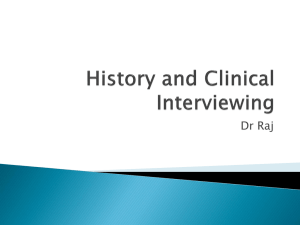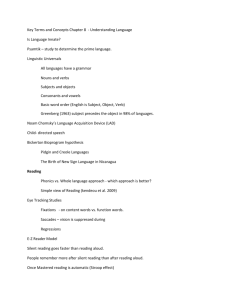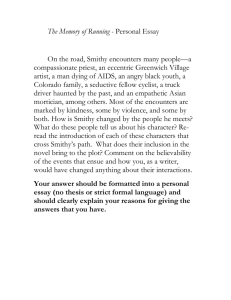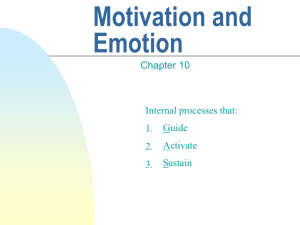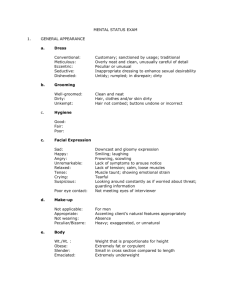An exploration of electrodermal activity
advertisement
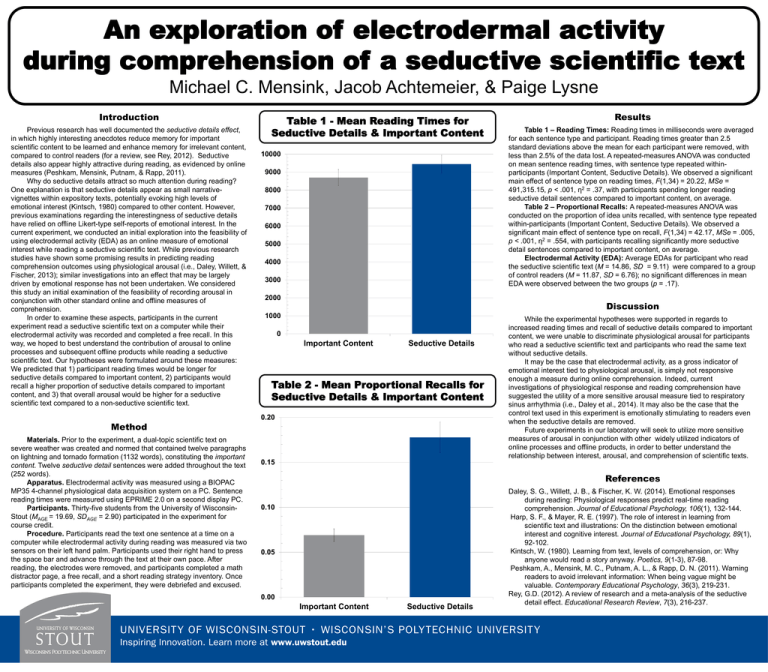
An exploration of electrodermal activity during comprehension of a seductive scientific text Michael C. Mensink, Jacob Achtemeier, & Paige Lysne Introduction Previous research has well documented the seductive details effect, in which highly interesting anecdotes reduce memory for important scientific content to be learned and enhance memory for irrelevant content, compared to control readers (for a review, see Rey, 2012). Seductive details also appear highly attractive during reading, as evidenced by online measures (Peshkam, Mensink, Putnam, & Rapp, 2011). Why do seductive details attract so much attention during reading? One explanation is that seductive details appear as small narrativevignettes within expository texts, potentially evoking high levels of emotional interest (Kintsch, 1980) compared to other content. However, previous examinations regarding the interestingness of seductive details have relied on offline Likert-type self-reports of emotional interest. In the current experiment, we conducted an initial exploration into the feasibility of using electrodermal activity (EDA) as an online measure of emotional interest while reading a seductive scientific text. While previous research studies have shown some promising results in predicting reading comprehension outcomes using physiological arousal (i.e., Daley, Willett, & Fischer, 2013); similar investigations into an effect that may be largely driven by emotional response has not been undertaken. We considered this study an initial examination of the feasibility of recording arousal in conjunction with other standard online and offline measures of comprehension. In order to examine these aspects, participants in the current experiment read a seductive scientific text on a computer while their electrodermal activity was recorded and completed a free recall. In this way, we hoped to best understand the contribution of arousal to online processes and subsequent offline products while reading a seductive scientific text. Our hypotheses were formulated around these measures: We predicted that 1) participant reading times would be longer for seductive details compared to important content, 2) participants would recall a higher proportion of seductive details compared to important content, and 3) that overall arousal would be higher for a seductive scientific text compared to a non-seductive scientific text. Method Materials. Prior to the experiment, a dual-topic scientific text on severe weather was created and normed that contained twelve paragraphs on lightning and tornado formation (1132 words), constituting the important content. Twelve seductive detail sentences were added throughout the text (252 words). Apparatus. Electrodermal activity was measured using a BIOPAC MP35 4-channel physiological data acquisition system on a PC. Sentence reading times were measured using EPRIME 2.0 on a second display PC. Participants. Thirty-five students from the University of WisconsinStout (MAGE = 19.69, SDAGE = 2.90) participated in the experiment for course credit. Procedure. Participants read the text one sentence at a time on a computer while electrodermal activity during reading was measured via two sensors on their left hand palm. Participants used their right hand to press the space bar and advance through the text at their own pace. After reading, the electrodes were removed, and participants completed a math distractor page, a free recall, and a short reading strategy inventory. Once participants completed the experiment, they were debriefed and excused. Table 1 - Mean Reading Times for Seductive Details & Important Content 10000 9000 8000 7000 6000 5000 4000 3000 2000 Results Table 1 – Reading Times: Reading times in milliseconds were averaged for each sentence type and participant. Reading times greater than 2.5 standard deviations above the mean for each participant were removed, with less than 2.5% of the data lost. A repeated-measures ANOVA was conducted on mean sentence reading times, with sentence type repeated withinparticipants (Important Content, Seductive Details). We observed a significant main effect of sentence type on reading times, F(1,34) = 20.22, MSe = 491,315.15, p < .001, η2 = .37, with participants spending longer reading seductive detail sentences compared to important content, on average. Table 2 – Proportional Recalls: A repeated-measures ANOVA was conducted on the proportion of idea units recalled, with sentence type repeated within-participants (Important Content, Seductive Details). We observed a significant main effect of sentence type on recall, F(1,34) = 42.17, MSe = .005, p < .001, η2 = .554, with participants recalling significantly more seductive detail sentences compared to important content, on average. Electrodermal Activity (EDA): Average EDAs for participant who read the seductive scientific text (M = 14.86, SD = 9.11) were compared to a group of control readers (M = 11.87, SD = 6.76); no significant differences in mean EDA were observed between the two groups (p = .17). Discussion 1000 0 Important Content Seductive Details Table 2 - Mean Proportional Recalls for Seductive Details & Important Content 0.20 0.15 While the experimental hypotheses were supported in regards to increased reading times and recall of seductive details compared to important content, we were unable to discriminate physiological arousal for participants who read a seductive scientific text and participants who read the same text without seductive details. It may be the case that electrodermal activity, as a gross indicator of emotional interest tied to physiological arousal, is simply not responsive enough a measure during online comprehension. Indeed, current investigations of physiological response and reading comprehension have suggested the utility of a more sensitive arousal measure tied to respiratory sinus arrhythmia (i.e., Daley et al., 2014). It may also be the case that the control text used in this experiment is emotionally stimulating to readers even when the seductive details are removed. Future experiments in our laboratory will seek to utilize more sensitive measures of arousal in conjunction with other widely utilized indicators of online processes and offline products, in order to better understand the relationship between interest, arousal, and comprehension of scientific texts. References 0.10 0.05 0.00 Important Content Seductive Details Daley, S. G., Willett, J. B., & Fischer, K. W. (2014). Emotional responses during reading: Physiological responses predict real-time reading comprehension. Journal of Educational Psychology, 106(1), 132-144. Harp, S. F., & Mayer, R. E. (1997). The role of interest in learning from scientific text and illustrations: On the distinction between emotional interest and cognitive interest. Journal of Educational Psychology, 89(1), 92-102. Kintsch, W. (1980). Learning from text, levels of comprehension, or: Why anyone would read a story anyway. Poetics, 9(1-3), 87-98. Peshkam, A., Mensink, M. C., Putnam, A. L., & Rapp, D. N. (2011). Warning readers to avoid irrelevant information: When being vague might be valuable. Contemporary Educational Psychology, 36(3), 219-231. Rey, G.D. (2012). A review of research and a meta-analysis of the seductive detail effect. Educational Research Review, 7(3), 216-237.
